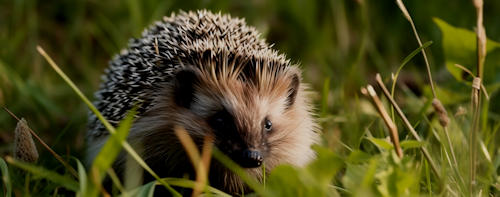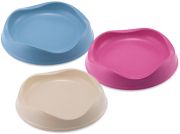Caring for hedgehogs in your garden

Caring for hedgehogs in your garden
by Louisa Roskilly
Since the millennium, hedgehog numbers have seen a worrying decline - as much as 75% in some parts of the UK! So much so, hedgehogs have now officially been classified as vulnerable to extinction. This is due to a number of factors including: habitat loss, road casualties and lack of food.
We have outlined below, a few ways you can give your prickly nighttime visitors a helping hand!
Wilding
Leave some areas of your garden ‘wild’ if you can. This could be an area of long grass/wildflower meadow. These areas will help to attract bugs and insects to your garden, in turn providing hedgehogs somewhere to snuffle around in to find insects, which make up the largest proportion of their natural diet (they don’t actually eat slugs as often as you might think!).
Access
You may have heard the term “hedgehog highway” used when talking about creating access for hedgehogs into your garden. The easiest way to achieve this is to make a square hole around 13cm (5") in the base of your boundary fence. If you are able to join forces with your neighbours (all making hedgehog holes) this creates a chain of interconnected gardens for them to travel through, thus creating a hedgehog highway!
 Creating a hedgehog highway is a great way of increasing habitat access!
Creating a hedgehog highway is a great way of increasing habitat access!
Feeding
To supplement their natural diet, you can put food out in a low sided bowl/saucer - a meaty wet cat or dog food is best (make sure to only use meat flavours!) alternatively you can provide a hedgehog specific dry food. If you are lucky enough to have more than one hedgehog visiting regularly, you can out another bowl - this can prevent any food-based arguments! And of course, makes sure water is always available.
Housing
In autumn, hedgehogs will naturally begin to collect nesting materials (dry leaves, grass, bracken, reeds etc.) However, in more suburban/built up areas, nesting materials can be a little harder to come by. This is where you come in! In a quiet, sheltered part of the garden, you can install a hedgehog house for day nesting and hibernating in during the winter. The British Hedgehog Preservation Society has some brilliant instructions for building your own that you can read here:
https://www.britishhedgehogs.org.uk/hedgehog-homes/
Alternatively, there are lots of ready-made houses available to buy. There are lots of styles to choose from. The majority are suitable; however, it has since been discovered that those made from woven materials (wicker, coir etc.) should be avoided due hedgehogs getting their spikes stuck!
General Care
- If you are lucky enough to catch a glimpse of your nighttime visitors, you can do a quick visual check from a distance for any visible injuries/illness (limping, being underweight etc.)
- Never feed bread or cows milk to hedgehogs as this can cause diarrhoea and other digestive issues.
- There should never be a reason to pick up a healthy hedgehog. However, if you see a hedgehog out in the daytime it’s highly likely to be poorly and should be taken to your nearest wildlife rescue or vet as soon as possible.
- As you can imagine, bonfires, log piles, and compost/leaf litter piles make for very cosy beds for out prickly pals so ALWAYS check before you light bonfires and fork over any leaf piles.
- It is common knowledge that hedgehogs carry fleas and ticks. This may deter some pet owners from welcoming them into their gardens. But worry not! These fleas are (hedgehog) species specific so pose absolutely no threat to your little ones.




